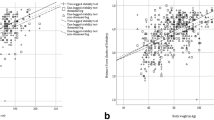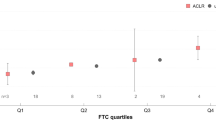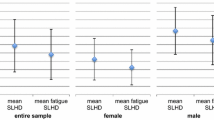Abstract
Purpose
Side-to-side asymmetry in side-cutting manoeuvres is a known risk factor for severe knee injury. Potential leg asymmetry during ground contact times of different change-of-direction manoeuvres was evaluated in athletes by means of the recently developed SpeedCourt® system. The hypotheses were that ground contact times and the limb symmetry index are affected by age and the type of sports.
Methods
One-hundred and sixty-five athletes (149 men, 16 women, age 16.5 ± 5.1) of popular team sports such as football, team handball and baseball were assessed by means of three different tests [side-hop, lateral change-of-direction (COD) and diagonal COD] using the SpeedCourt® system. Analysis included the factors age, sex, type of sports, ground contact time, leg symmetry index and limb dominance.
Results
During lateral but not diagonal COD tests, football players had shorter contact times than players of team handball (p = 0.026) and baseball (p = 0.015) of the same age group. The side-hop tests yielded differences in the leg symmetry index between players < 16 years and players > 16 years (p < 0.01). Mean ground contact time differed in each of the side-hop, lateral COD and diagonal COD tests (143.5 ± 20.0 vs. 256.2 ± 66.1 vs. 320.4 ± 55.0). Contact times and test durations of side-hop, lateral COD and diagonal COD tests were shorter for older players (p < 0.01).
Conclusions
Ground contact times of side-hop and change-of-direction manoeuvres are influenced by age, the type of sports and limb dominance. Such information is fundamental for future sports medicine research and needs to be considered in pre-season screening or when used as a criterion for return-to-competition of players with previous severe knee injury. Assessment of change-of-direction manoeuvres should be included in future return-to-competition test batteries.
Level of evidence
III.



Similar content being viewed by others
References
Alentorn-Geli E, Myer GD, Silvers HJ, Samitier G, Romero D, Lazaro-Haro C, Cugat R (2009) Prevention of non-contact anterior cruciate ligament injuries in soccer players. Part 1: mechanism of injury and underlying risk factors. Knee Surg Sports Traumatol Arthrosc 17(7):705–729
Ardern CL, Taylor NF, Feller JA, Webster KE (2014) Fifty-five per cent return to competitive sport following anterior cruciate ligament reconstruction surgery: an updated systematic review and meta-analysis including aspects of physical functioning and contextual factors. Br J Sports Med 48(21):1543–1552
Barber FA, Cowden CH 3rd, Sanders EJ (2014) Revision rates after anterior cruciate ligament reconstruction using bone-patellar tendon-bone allograft or autograft in a population 25 years old and younger. Arthroscopy 30(4):483–491
Barber-Westin SD, Noyes FR (2011) Factors used to determine return to unrestricted sports activities after anterior cruciate ligament reconstruction. Arthroscopy 27(12):1697–1705
Bartels T, Proeger S, Brehme K, Pyschik M, Delank KS, Schulze S, Schwesig R, Fieseler G (2016) The SpeedCourt system in rehabilitation after reconstruction surgery of the anterior cruciate ligament (ACL). Arch Orthop Trauma Surg 136(7):957–966
Bailey C, Sato K, Burnett A, Stone MH (2015) Force-production asymmetry in male and female athletes of differing strength levels. Int J Sports Physiol Perform 10(4):504–508
Bishop C, Read P, Chavda S, Turner A (2016) Asymmetries of the lower limb: the calculation conundrum in strength training and conditioning. Strength Cond J 38:27–32
Borotikar B, Newcomer R, Koppes R, Mclean S (2008) Combined effects of fatigue and decision making on female lower limb landing postures: central and peripheral contributions to ACL injury risk. Clin Biomech 23(1):81–92
Brophy R, Silvers HJ, Tyler G, Mandelbaum BR (2009) Gender influences: the role of leg dominance in ACL injury among soccer players. Br J Sports Med 44(10):694–697
Carling C (2013) Interpreting physical performance in professional soccer match-play: should we be more pragmatic in our approach? Sports Med 43(8):655–663
Condello G, Kernozek TW, Tessitore A, Foster C (2016) Biomechanical analysis of change-of-direction task in collegiate soccer players. Int J Sports Physiol Perform 11(1):96–101
Dos’Santos T, Thomas C, Jones PA, Comfort P (2017) Mechanical determinants of faster change of direction speed performance in male athletes. J Strength Cond Res 31(3):696–705
Düking P, Born DP, Sperlich B (2016) The SpeedCourt: reliability, usefulness, and validity of a new method to determine change-of-direction speed. Int J Sports Phys Perform 11(1):130–134
Engelman GH, Carry PM, Hitt KG, Polousky JD, Vidal AF (2014) Comparison of allograft versus autograft anterior cruciate ligament reconstruction graft survival in an active adolescent cohort. Am J Sports Med 42(10):2311–2318
Goerger BM, Marshall SW, Beutler AI, Blackburn JT, Wilckens JH, Padua DA (2015) Anterior cruciate ligament injury alters preinjury lower extremity biomechanics in the injured and uninjured leg: the JUMP-ACL study. Br J Sports Med 49(3):188–195
Gokeler A, Welling W, Benjaminse A, Lemmink K, Seil R, Zaffagnini S (2017) A critical analysis of limb symmtry indices of hop tests in athletes after anterior cruciate ligament reconstruction: a case control study. Orthop Traumatol Surg Res 103(6):947–951
Greska EK, Cortes N, Ringleb SI, Onate JA, van Lunen BL (2017) Biomechanical differences related to leg dominance were not found during a cutting task. Scand J Med Sci Sports 27(11):1328–1336
Grindem H, Snyder-Mackler L, Moksnes H, Engebretsen L, Risberg MA (2016) Simple decision rules can reduce reinjury risk by 84% after ACL reconstruction: the Delaware-Oslo ACL cohort study. Br J Sports Med 50(13):804–808
Hannon J, Wang-Price S, Goto S, Garrison JC, Bothwell JM (2017) Do muscle strength deficits of the uninvolved hip and knee exist in young athletes before anterior cruciate ligament reconstruction? Orthop J Sports Med 5(1):2325967116683941
Hewett TE, Myer GD, Ford KR, Heidt RS Jr, Colosimo AJ, McLean SG, van den Bogert AJ, Paterno MV, Succop P (2005) Biomechanical measures of neuromuscular control and valgus loading of the knee predict anterior cruciate ligament injury risk in female athletes: a prospective study. Am J Sports Med 33(4):492–501
Itoh H, Kurosaka M, Yoshiya S, Ichihashi N, Mizuno K (1998) Evaluation of functional deficits determined by four different hop tests in patients with anterior cruciate ligament deficiency. Knee Surg Sports Traumatol Arthrosc 6(4):241–245
Keeley DW, Plummer HA, Oliver GD (2011) Predicting asymmetrical lower extremity strength deficits in college-aged men and women using common horizontal and vertical power field tests: a possible screening mechanism. J Strength Cond Res 25(6):1632–1637
Krutsch W, Zeman F, Zellner J, Pfeifer C, Nerlich M, Angele P (2016) Increase in ACL and PCL injuries after implementation of a new professional football league. Knee Surg Sports Traumatol Arthrosc 24(7):2271–2279
Krüger K, Pilat C, Ueckert K, Frech T, Morren FC (2014) Physical performance profile of handball players is related to playing position and playing class. J Strength Cond Res 28(1):117–125
Luig P, Krutsch W, Nerlich M, Henke T, Klein C, Bloch H, Platen P, Achenbach L (2018) Increased injury rates after the restructure of Germany’s national second league of team handball. Knee Surg Sports Traumatol Arthrosc. https://doi.org/10.1007/s00167-018-4851-4
Maloney SJ, Richards J, Nixon DG, Harvey LJ, Fletcher IM (2017) Do stiffness and asymmetries predict change of direction performance? J Sports Sci 35(6):547–556
McLean S, Felin R, Suedekum N, Calabrese G, Passerallo A, Joy S (2007) Impact of fatigue on gender-based high-risk landing strategies. Med Sci Sports Exerc 39(3):502–514
Marshall BM, Franklyn-Miller AD, King EA, Moran KA, Strike SC, Falvey EC (2014) Biomechanical factors associated with time to complete a change of direction cutting maneuver. J Strength Cond Res 28(19):2845–2851
Paterno MV, Rauh MJ, Schmitt LC, Ford KR, Hewett TE (2014) Incidence of second ACL injuries 2 years after primary ACL reconstruction and return to sport. Am J Sports Med 42(7):1567–1573
Read PJ, Oliver JL, Myer GD, De Ste Croix MBA, Llyod RS (2018) The effectos of maturation on measures of asymmetry during neuromuscular control tests in elite male youth soccer players. Pediatr Exerc Sci 30(10):168–175
Thomee R, Kaplan Y, Kvist J, Myklebust G, Risberg MA, Theisen D, Tsepis E, Werner S, Wondrasch B, Witvrouw E (2011) Muscle strength and hop performance criteria prior to return to sports after ACL reconstruction. Knee Surg Sports Traumatol Arthrosc 19(11):1798–1805
Xie D, Urabe Y, Ochiai J, Kobayashi E, Maeda N (2013) Sidestep cutting maneuvers in female basketball players: stop phase poses greater risk for anterior cruciate ligament injury. Knee 20(2):85–89
Acknowledgements
We thank the participating teams, Globalspeed GmbH, Germany, and the Centre for Clinical Studies at the University Medical Centre Regensburg, Germany, for their assistance.
Funding
None.
Author information
Authors and Affiliations
Corresponding author
Ethics declarations
Conflict of interest
All authors declare no conflict of interest for this study.
Ethical approval
The study design was approved by the Ethics Committee of the University of Regensburg (ID 17-895-101).
Informed consent
Informed written consent was obtained from all study participants and their parents.
Rights and permissions
About this article
Cite this article
Achenbach, L., Krutsch, W., Koch, M. et al. Contact times of change-of-direction manoeuvres are influenced by age and the type of sports: a novel protocol using the SpeedCourt® system. Knee Surg Sports Traumatol Arthrosc 27, 991–999 (2019). https://doi.org/10.1007/s00167-018-5192-z
Received:
Accepted:
Published:
Issue Date:
DOI: https://doi.org/10.1007/s00167-018-5192-z




